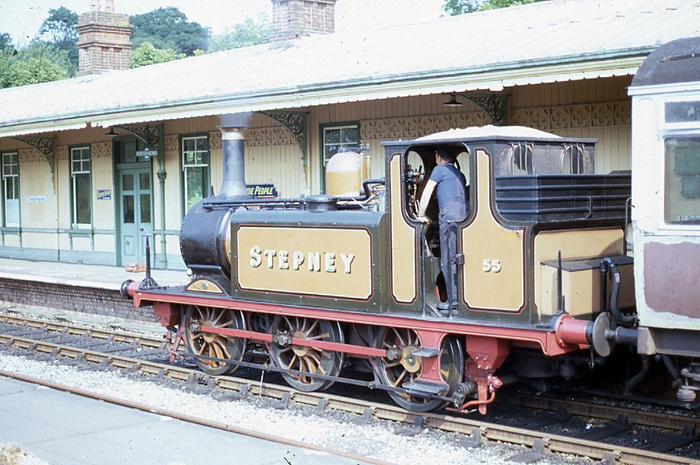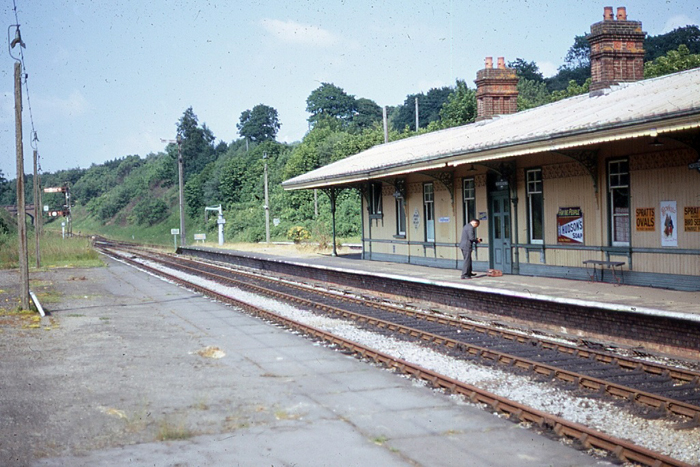
Horsted Keynes
Bluebell & Primrose Line
The island platforms
measured 470-feet in length, and each was host to an attractive pitched-roof
canopy. The latter were 195-feet long, supported upon two lines of wrought-iron
stanchions, and comprised sloping roof ends and ornate timber valances. The
canopies housed timber-built platform offices underneath, and design of the
former was
standardised along the route. The side platform, on the ‘’down’’ side, was
shorter than the islands, measuring 425-feet in length; this was as a result of
a cattle dock line terminating against the platform’s southern end. The layout
here was arranged in such a way that the ‘’down’’ side platform and island
served the same section of single-track – thus, if a train was in, a passenger
could clamber through the carriage compartments to change platforms, as opposed
to using the subway! The main station building was an impressive affair, and was
situated upon the ‘’down’’ side platform. It was built to a standardised design
used at all stations along the Bluebell & Primrose route, and comprised a
substantial two-storey-high main section housing the Station
Master’s accommodation. The ground floor of the structure was brick built,
whilst the first floor was fabricated from a timber framework, the gaps between
the beams being in-filled with plaster. The gabled pitched roof sections,
although also comprising a timber framework, were clad with vertically-hung clay
tiles. The main building was flanked on either side by single-storey appendices
(one of which housed the booking office),
and extending from its western elevation was a 112-foot-long platform canopy,
built to the same design as those which appeared on the island surfaces. Gas
lighting was used throughout the station.
The layout here was spacious, and to the immediate west of the ‘’up’’ island was
a trio of northward-facing sidings. These were initially used for general
rolling stock storage, but later became a dump for withdrawn locomotives either
awaiting overhaul at Brighton, or scrapping. They were accompanied at the site
by a further six sidings; the latter were positioned immediately south of the
‘’down’’ side platform, were southward-facing, and required a head shunt
manoeuvre to gain access. The station was signalled by the LB&SCR itself, and two cabins appeared, north and south of the
platforms, based heavily on those designs pioneered by contractor Saxby & Farmer. ‘’South Box’’ was positioned at the end of the ‘’up’’ sidings, and
comprised 33 levers to control the junction between the diverging Lewes and Haywards Heath routes. It was the largest signal cabin on the Bluebell &
Primrose line, the structure at Kingscote coming a close second. This same
design of signal box was used throughout on the ''Cuckoo Line'' between Eridge
and Polegate. Horsted Keynes’ ‘’North Box’’ was positioned 60 yards beyond the London end of
the ‘’down’’ island, and operated a series of crossovers immediately beyond the
platforms.
Changes at the station occurred around the turn of the century. The
wood and plaster panelling of the station building’s upper floor was completely
covered over with vertically-hung clay tiling, extended down from the pitched
roof sections. This was a task undertaken at all stations along the route –
unfortunately, the plaster leaked badly! In the months prior to the declaration
of war in August 1914, rationalisation of the layout occurred. This involved
downgrading ‘’North Box’’ to ground frame status, and thus the abolition of the
‘’North’’ and ‘’South’’ designations. The former ‘'South Box’’ became the prime
cabin, and a revision of the track layout at the junction gave trains using
the eastern-most platform line direct access to the Haywards Heath spur –
previously, onward southward travel from this line led only to the Lewes route
via Sheffield Park. To afford the signalman a clear view over the entire track
layout, particularly the region once covered by ‘’North Box’’, the canopy and
timber offices of the ‘’up’’ island were demolished.
The Bluebell & Primrose line was absorbed into the Southern Railway on Grouping
in 1923, and this company implemented its own wave of significant alterations.
These began in about 1930, with the simplification of the remaining ‘’down’’
island canopy: the sloping ends were removed, and a plain timber valance
installed. The eastern-most platform canopy, attached to the main building,
remained largely unchanged, retaining the original 1882 shape, albeit with
truncated valance. On New Year’s Day 1933, the SR implemented a full accelerated
electric timetable between London and Brighton, and two years later, this was
followed by the completion of electrification schemes on lines radiating out of
Lewes. Installation of third rail occurred between Lewes and Keymer Junction
(south of Haywards Heath), along the ‘’East Coast’’ route between Brighton and
Ore, and down the branch lines to Seaford and Eastbourne. As part of the same
electrification scheme, third rail was also laid along the Ardingly spur,
between Copyhold Junction (north of Haywards Heath) and Horsted Keynes. This was
in preparation for the commencement of a Seaford to Haywards Heath electric
service: terminating the train at the latter would have used up much needed platform
capacity upon an already congested main line. The proposed electric service was
therefore extended through to Horsted Keynes, which was upon a route operating
to a very relaxed timetable. Electric operation upon the aforementioned routes
commenced on 4th July 1935, and modifications had already been made at Horsted
Keynes in preparation for this. Severe rationalisation of the track layout
occurred, which involved the decommissioning of the western-most platform line,
and the removal of two of the adjacent sidings. The Ardingly line remained
double-track, but only the sole remaining line
which served the ‘’up’’ island was electrified
–
the rest of Horsted Keynes' layout lacked third rail. The former ‘’North Box’’, by now a ground frame,
was totally abolished, and control of a much simplified track layout fell wholly
to the remaining signal box at the junction between the Haywards Heath and Lewes
routes. On the plus side, however, the 1935 electrification had at least seen
the commissioning of electric lighting on all platform surfaces. This system was
supported upon concrete lampposts and was most probably fed directly from the
supply of the third rail, especially in light of the fact that Horsted Keynes
was the only station along the 1882 route to receive electric lighting.
June 1967

No. 55 ''Stepney'', a Class A1X ''Terrier'', was the Bluebell's first locomotive, arriving at Sheffield Park in 1960. The locomotive was withdrawn from Fratton shed (Portsmouth) in that year and was purchased directly from BR. The extensive timber platform offices on Horsted Keynes' ''down'' island, seen above, were in nearly as good cosmetic condition as the engine in front of them. © David Glasspool Collection
June 1967

A southward view shows ''Stepney'' to be hauling ex-LNWR Observation Car No. 1503, which at that time had yet to be fully cosmetically restored. On the right, we can see the former ''up'' island, which lost its offices and canopy as long ago as the Great War. Conversely, however, it was also the last part of the station to be served by BR trains. The exposed subway entrance is evident and, behind that, the tank-less water tower. © David Glasspool Collection
June 1967

A northward view includes a surviving water column at the end of the ''down'' island. On all platforms can be seen concrete posts which once carried electric lighting, a legacy of the electrification of the Ardingly branch. © David Glasspool Collection
<< Previous Next: The History Continues >>
Return to the Kent Rail Homepage or alternatively, check for Updates.
Website & Copyright information - Links - Contact the Webmaster
All content is copyright © David Glasspool unless otherwise stated